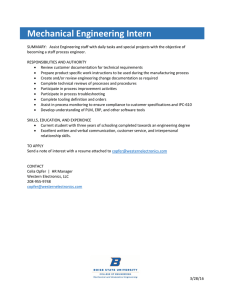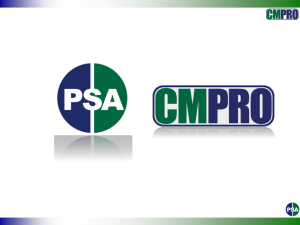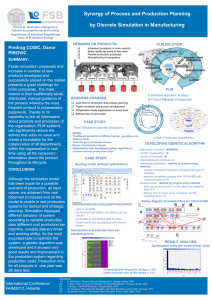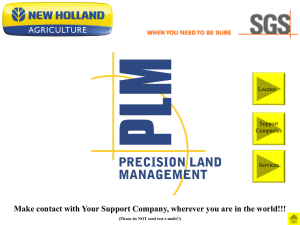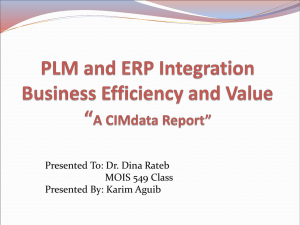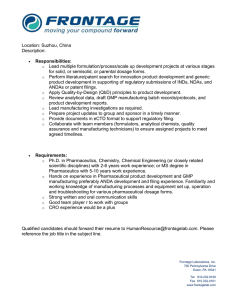A Holistic Approach to Pharmaceutical Manufacturing: Product Lifecycle
advertisement
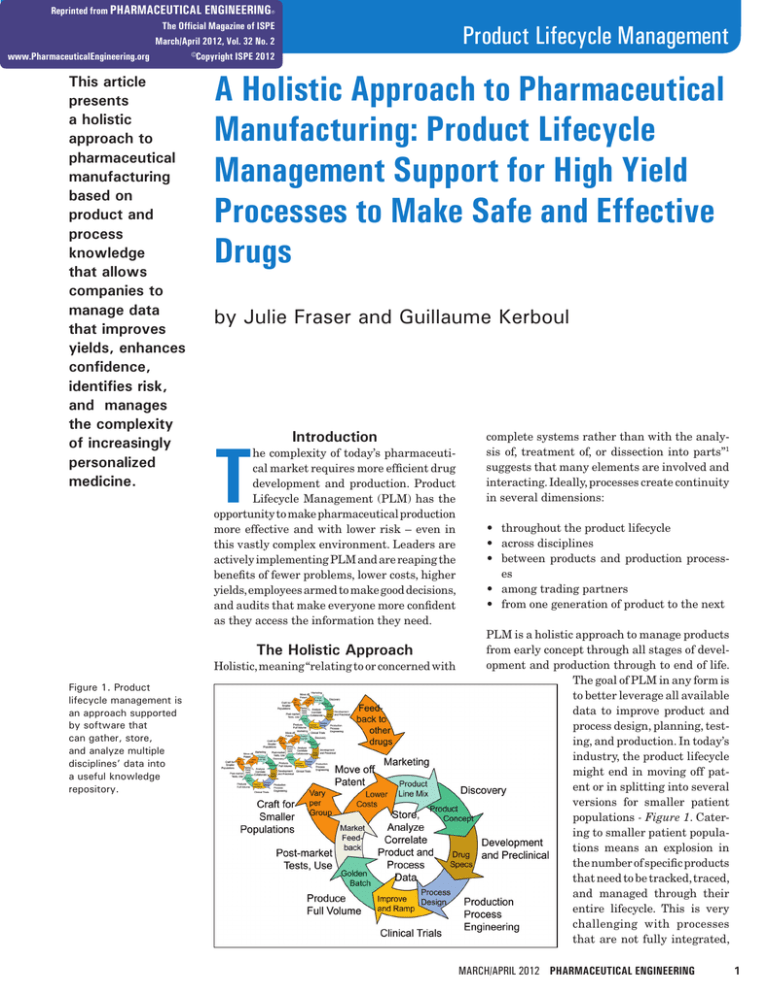
Reprinted from PHARMACEUTICAL ENGINEERING® The Official Magazine of ISPE March/April 2012, Vol. 32 No. 2 www.PharmaceuticalEngineering.org ©Copyright ISPE 2012 This article presents a holistic approach to pharmaceutical manufacturing based on product and process knowledge that allows companies to manage data that improves yields, enhances confidence, identifies risk, and manages the complexity of increasingly personalized medicine. Product Lifecycle Management A Holistic Approach to Pharmaceutical Manufacturing: Product Lifecycle Management Support for High Yield Processes to Make Safe and Effective Drugs by Julie Fraser and Guillaume Kerboul T Introduction he complexity of today’s pharmaceutical market requires more efficient drug development and production. Product Lifecycle Management (PLM) has the opportunity to make pharmaceutical production more effective and with lower risk – even in this vastly complex environment. Leaders are actively implementing PLM and are reaping the benefits of fewer problems, lower costs, higher yields, employees armed to make good decisions, and audits that make everyone more confident as they access the information they need. The Holistic Approach Holistic, meaning “relating to or concerned with Figure 1. Product lifecycle management is an approach supported by software that can gather, store, and analyze multiple disciplines’ data into a useful knowledge repository. complete systems rather than with the analysis of, treatment of, or dissection into parts”1 suggests that many elements are involved and interacting. Ideally, processes create continuity in several dimensions: • throughout the product lifecycle • across disciplines • between products and production processes • among trading partners • from one generation of product to the next PLM is a holistic approach to manage products from early concept through all stages of development and production through to end of life. The goal of PLM in any form is to better leverage all available data to improve product and process design, planning, testing, and production. In today’s industry, the product lifecycle might end in moving off patent or in splitting into several versions for smaller patient populations - Figure 1. Catering to smaller patient populations means an explosion in the number of specific products that need to be tracked, traced, and managed through their entire lifecycle. This is very challenging with processes that are not fully integrated, March/April 2012 PHARMACEUTICAL ENGINEERING 1 Product Lifecycle Management leading to another driver for managing all of these products in a PLM software system. This ability to build a knowledge base from every aspect of the process contributes to the success of all other aspects and phases of a product’s life, and to the success of other products in the portfolio. In the pharmaceutical environment, this reduces the need for regulatory oversight: safe, efficacious products are the natural outcome of this holistic PLM approach. One initiative supported by PLM is Quality by Design (QbD), outlined in ICH Q8 Product Development standards.2 While some people think that QbD is purely a statistically-focused approach, the concept is much broader. QbD is a product/process lifecycle approach founded on continuous improvement as the FDA3 illustrates it in Figure 2. Notice how similar the PLM and QbD models are, each representing a closed loop cycle. Because of the need for analysis, QbD efforts have used largely esoteric mathematical, analytical, and statistical methods. While these are the critical scientific foundation, they may actually mask the overall holistic QbD program for staff who are not statisticians, but who have an important role to play. Figure 3a shows the struggle most companies have to achieve QbD or any lifecycle approach. The separate information environments means that the various teams often cannot Figure 3a. Typical current silo state: minimal cross-discipline understanding. Figure 2. Quality by Design is a cycle in which product and process design and performance create a closed loop of knowledge and continuous improvement (source: FDA’s view on QbD, Moheb Nasr, 2006). Figure 3b. PLM system support enables cross-discipline knowledge sharing and better context for all groups’ decisions. Traditional multi-disciplinary silos (3a) with independent information systems create challenges that a PLM approach (3b) can overcome with common data management, advanced analysis, and support of knowledge from many disciplines. 2 PHARMACEUTICAL ENGINEERING March/April 2012 Product Lifecycle Management leverage each others’ work fully. They typically use different terminology, have different viewpoints, use and create different data, and leverage independent information systems. While everyone involved is theoretically striving toward the same goal, these information disconnects can lead to a lack of understanding and incomplete risk analysis. Figure 3b illustrates the PLM approach supported by a centralized and industry-specific PLM application suite, which for pharmaceutical includes regulatory business process and submission workflows, portfolio and formulation management, manufacturing analytics, supply chain scorecards and sourcing applications, in addition to engineering and equipment design applications. The PLM platform brings together all relevant information and delivers structured processes by which disciplines can work together to proactively improve product quality. Using structured approaches helps to minimize process and product variation and risk. PLM has helped to lower cost, increase yield, and deliver significant benefits to the companies who use it, and to their customers. For example, in the early product formulation stages, quality, process engineering, and manufacturing are involved to ensure the team fully considers lessons learned from previous products. This helps to prevent blind spots and disconnects, thus reducing risks and timelines. Both QbD and PLM have product yield and quality in mind from the earliest discovery stages. In this way, PLM and QbD also improve innovation, shorten overall product introduction times, and support regulators’ confidence. Obstacles to Quality by Design Pharmaceutical manufacturing executives must recognize where their current approaches fall short and develop a path to enable company success. Representatives from regulators as well as the International Conference on Harmonisation (ICH) of Technical Requirements for Registration of Pharmaceuticals for Human Use have presented some of these shortcomings in a systematic way. Briefly, these problematic practices to avoid include: • Quality by test. Off-line analysis can result in low yield, as it allows products that will not pass final tests to go through the process. The result is increased cost, cycle time, and risk, as the company scraps products and requires a second production run to get acceptable quality product out. • Issue correction without prevention. A primary focus in manufacturing on corrective action, not preventative action raises the risk that problems will recur, wasting cost and time. Part of the challenge is that prevention must typically be built into the design of the production process itself, and many companies have processes that are not designed to stay within the boundaries for high quality production outputs. • Silos of data and knowledge. Most companies have data owned by different departments or disciplines. For example, production data from one product often is not readily available for designers of follow-on products and their production processes. The data is in different forms and thus not often used as context for forming an overall knowledge base about the product and production process. This is true from stage to stage (development to clinical trials to full production), but also in some cases among the groups that service production and process development, such as statistics and multivariate analysis, spectroscopy, mathematical modeling, and risk assessment. • An empirical or variable-by-variable approach to pharmaceutical development. This results in a costly and slow process that is also vulnerable to blind spots because it cannot account for the interaction between variables that frequently cause problems in trials and in scaled-up full production. Even in multi-variate approaches, the focus on an average rather than the distribution of outcomes (i.e., minimizing the likelihood of batches that are out of specification) can limit production success. • Change-resistant processes. Once validated, the production process becomes fixed and focused on reproducing outcomes. This limits the companies’ interest in pursuing new technologies and process improvements that would result in higher yields at lower cost. Understanding these shortcomings of the current process development approach, regulators and the ICH have started to promote holistic approaches, shown in the middle column of Table A. Across the industry, leading pharmaceutical producers are beginning to shift their business processes to new approaches that better leverage knowledge. Pragmatic Ways to Get Started PLM is a big vision for product and process development, validation, and execution. To gain the benefits, most companies will require new approaches, mindsets, and information flows. The magnitude of the change is one reason pharmaceutical companies have only recently started to move to PLM practices and QbD submissions. Another is that the software support has been scattered, and is just coming together in PLM software suites recently. The capabilities that PLM software has to support the enhanced approach regulators favor are listed in the right-hand column of Table A. Some pharmaceutical companies have started their QbD journey in specific areas with focused software that fits into a PLM suite and are gaining benefits already. Eli Lilly is using simulation of code for production process control systems. This software actually runs process design data through scenarios on the company’s equipment prior to the first production runs. Eli Lilly’s project manager reports their results: “Using this software, our team delivered the project three months early, simulated the whole plant (actuators and sensors), and rapidly implemented the control system while increasing production quality. The integration tests using this tool acted as support for qualification.” March/April 2012 PHARMACEUTICAL ENGINEERING 3 Product Lifecycle Management Q8 Approaches to Pharmaceutical Development PM System Support Capabilities Minimal Approach Enhanced, QbD Approach Fixed manufacturing process Manufacturing process adjustable within the design space Structured change management based on specifications and analysis Focus on reproducibility Focus on control strategy and robustness of the process Virtual manufacturing with simulation of the process and product outcomes Off-line analysis PAT tools used for feed forward and feedback process control Process design creates control parameters, and data management handles data from process control Quality assured by testing Risk-based control strategy (real-time release) Risk management analysis data stored and in context and accessible Empirical development Systematic approach to development System support for development process using scientific and empirical data One variable at a time Multivariate experiment Multiple variable analysis to minimize out of spec., not average, results Reactive lifecycle management Preventive lifecycle management (and continual improvement) Multi-disciplinary data and collaboration from earliest product/process concept Adapted from: 10/2008 Presentation: QbD: A Global Implementation Perspective The EU Perspective by Richardo Luigetti of EMEA at the Siena Conference on Product and Process Optimization Table A. While ICH Q8 will accept the traditional “minimal” approach, it pushes for the QbD approach, which PLM enables and fosters. Sanofi Pasteur is using an analytical software tool to understand best practices in its operation. Beyond what traditional multi-variate analysis can do, this software is easier for manufacturing teams to understand and use. “This tool is particularly successful where other, more classic analysis tools fail. By producing simple and explicit rules that explain the functioning of our vaccine production processes and by highlighting the parameter correlations that may cause these processes to deteriorate, this tool helps us to improve process quality, security, and profitability,” according to René Labatut, VP Global Manufacturing Technology. Each company will have its own path to move toward the holistic PLM approach. Specifics will depend on the company’s current practices, stages in their products’ lifecycles, technologies in place, etc. It’s often best to start with a specific product, process, or project to gain confidence, but the goal must be to generate a company-wide shift over time. In short, moving to PLM will usually need a champion with executive level support to effect the required changes in people, processes, and technology. To keep support, companies must get quick wins. What follows are some basic concepts to help managers get each of these areas started on the journey. • Participate in training or education or workshops to get your team up to speed. Public sessions relating to both QbD and PLM are relatively common. If only a few of your team or certain disciplines have attended these sessions, we recommend enrolling entire cross-disciplinary teams in overview sessions. As teams begin to share knowledge, they will gain better understanding and begin to establish common terminology and expectations. • Involve cross-disciplinary teams in designing new processes to move toward a holistic approach. These new processes may focus on creating a knowledge inventory, defining CQAs, reducing variability in ingredients or in processes, formulation scale-up, or simply opening lines of communica4 PHARMACEUTICAL ENGINEERING March/April 2012 tion between disciplines at critical points in each group’s process. • Technology that is proactive and holistic across the product lifecycle can enable both process change and education. It’s important to have the total PLM roadmap in mind, but some companies will start small and build out. There are quite a few possibilities for starting points, including: - Leverage a system that supports effective production process design with simulation and verification of results for each product and variant to be produced on that line. - Implement a system that helps find quantitative and qualitative data in multiple electronic sources quickly and efficiently to foster early collaboration between product development and manufacturing experts. - Use technology to deliver the data and analysis you need to characterize and optimize the manufacturing process. Technologies might include plant data systems to capture actual data from processes and operations intelligence that analyzes product and process data. - Set up electronic batch records to enforce processes, make data more coherent and available, and automate according to 21 CFR Part 11. These systems also speed audits, process knowledge gathering, non-conformance analysis, and recalls. - Use a tool that can analyze data from manufacturing operations to identify best practices. PLM in Action PLM is not just an effective tool for pharmaceutical companies. Global organizations from just about every industry benefit Product Lifecycle Management from it. From these brief case studies, pharmaceutical organizations can learn exactly how to incorporate PLM within their infrastructures to achieve their desired operational benefits. • A leading helicopter company moved from 467 legacy systems per site/department/discipline to consistent, rolebased enterprise systems for 20 core business processes including PLM. PLM was rolled out first because the company wanted to get the core product data correct so they could quickly and fully reposition the business to be more responsive and cost-effective. Pharmaceutical companies can learn from this because they frequently have multiple systems hosting confusing, inconsistent product information. PLM gives one version of the truth for all of this company’s employees to access. • An inspection and metrology tool company went from a customized system for PLM to a new standard platform. They have achieved up to a 10X time to market performance improvement by collaborating with customers, employees, suppliers. Speed to market is a major concern of pharmaceutical companies as they struggle to get products into the market and maximize their time under patent. PLM allows organizations to holistically manage quality and compliance with internal employees as well as outsourced partners. • An aircraft manufacturer used PLM to reduced problems or nonconformance in their first prototype by 50% by simulating the product and the production process. They are eliminating paper in their production plants. This is an example of how PLM can be used to improve product quality in early stages – equivalent to clinical trial stages for pharmaceutical companies. Urgency to Improve for Safety and Performance Companies in every position in the pharmaceutical industry are under unprecedented pressure from regulators and shareholders to improve performance. This typically requires an improvement in manufacturing yield and repeatability. In addition, new opportunities are emerging to serve worldwide markets and in some cases, with drugs targeted to smaller populations offering improved safety and efficacy as well. With the resulting complexity, pharmaceutical companies must develop a cross-discipline lifecycle knowledge base with instant information access. Other industries with human safety issues and varying global regulations, such as aerospace, defense, and automotive have proven the value of PLM software. While these industries are not finished improving, they have managed to reduce costs, improve efficiency, and adhere to very high quality and safety standards. The pharmaceutical industry is on the brink of a new era. People, paper, and domain-specific systems can no longer keep up with the complexity and business pressures. Leaders are turning to PLM as a holistic approach based on product and process knowledge. Moving from inconsistent data in disconnected systems to a PLM environment with supporting software allows companies to manage data in a way that improved yields, enhances confidence, more clearly identifies risk, and is capable of managing the complexity of increasingly personalized medicine. All of this is likely to lead to satisfied regulators and happier shareholders. References 1. Merriam-Webster on-line dictionary: http://www.merriamwebster.com/dictionary/holistic. 2. International Conference on Harmonisation of Technical Requirements for Registration of Pharmaceuticals for Human Use, ICH Harmonised Tripartite Guideline, Pharmaceutical Development – Q8(R2), August 2009, www.ich. org. 3. Winkle, Helen, “Implementing Quality by Design,” presented at PDA/FDA Joint Regulatory Conference, September 2007. About the Authors Julie Fraser and Cambashi are passionate about helping IT companies succeed and their customers gain a competitive edge. With 25 years of experience as a manufacturing systems industry advisor, Fraser is President of US operations for UK-based analyst and market research firm Cambashi. In this role, she has led many proprietary customer projects as well as research studies in manufacturing performance metrics and medical device manufacturing issues. Prior to joining Cambashi, Fraser ran analyst firm Industry Directions. Prior to that, she was VP marketing for Baan Supply Chain Solutions, senior analyst on MES at AMR, and editorin-chief of the CIM Strategies newsletter. She is a member of Phi Beta Kappa, and co-chairs MESA International’s Metrics Working Group. Guillaume Kerboul is currently the Pharmaceutical Solution Leader at Dassault Systèmes (DS). He is part of the Life Sciences organization that is responsible for creating and developing DS strategy and associated solutions for pharmaceutical, medical devices, and patient care industry segments. Since joining the company,. Kerboul has worked with leading life sciences companies and quality software editors to develop and support business strategies in the areas of product development and cross-enterprise collaboration. March/April 2012 PHARMACEUTICAL ENGINEERING 5
